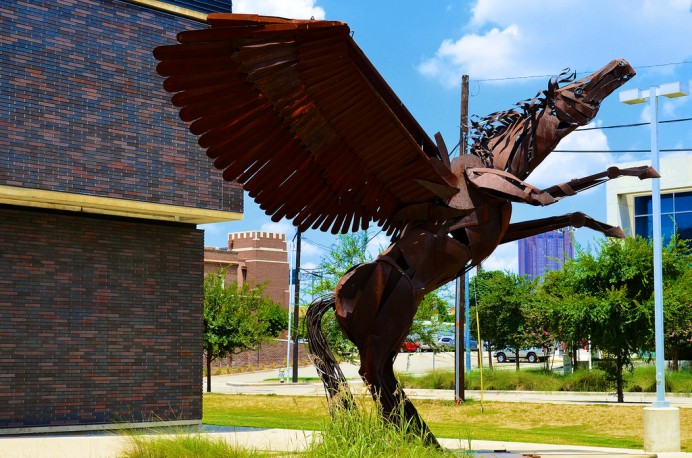
Obviously for a walk in the Dallas Arts District, it’s important to highlight ways in which math and art interact with and enrich each other. One opportunity to do that is the sculpture of Pegasus by artist Stuart Kraft at the Booker T. Washington High School for the Visual and Performing Arts. There are at least two points of contact between math and the arts that you might highlight here. One is that the choice of Pegasus as subject for this artwork is almost certainly not coincidental, as Pegasus is at least to some extent a symbol of Dallas, if for no other reason than the long history of the red Pegasus sign on the Magnolia Oil building. And like art, mathematics depends on the disciplined use of symbols. While the meaning and uses of mathematical symbols may be more narrow and regimented that of artistic symbols, it’s important to remember that in both cases, the use of symbols stems from the central, human drive to communicate. Both art and math communicate ideas, concepts, and relationships, and the use of symbols enhances the power of those communications.
More concretely, if you ask visitors to look closely at the pieces of steel that make up Pegasus and describe their shapes, you will see that although some individual pieces, as in the mane, are free-form and defy easy description, the bulk of the pieces generally conform to simple, familiar geometric shapes. You will see triangles, for example in the neck of the horse; pieces of cylinders, for example in the wings; circles, particularly in the rear hip of the horse. This echoes a familiar technique that underlies much of mathematics, which is to take a complicated problem, situation, or object, and analyze it by breaking it down into many small constituent parts. Moreover, the details of those parts can help to understand the function of the whole. So for example, in Pegasus, the circle at the hip reflects how that joint can freely rotate over a large range of motion, just as a circle can be rotated any amount and yet still match up with itself. To produce the most striking rendition of his subject, the artist needs to understand and appreciate how these simple forms, in a very mathematical way, make up something as flowing and dynamic and subtly contoured as Pegasus about to spring into flight.

